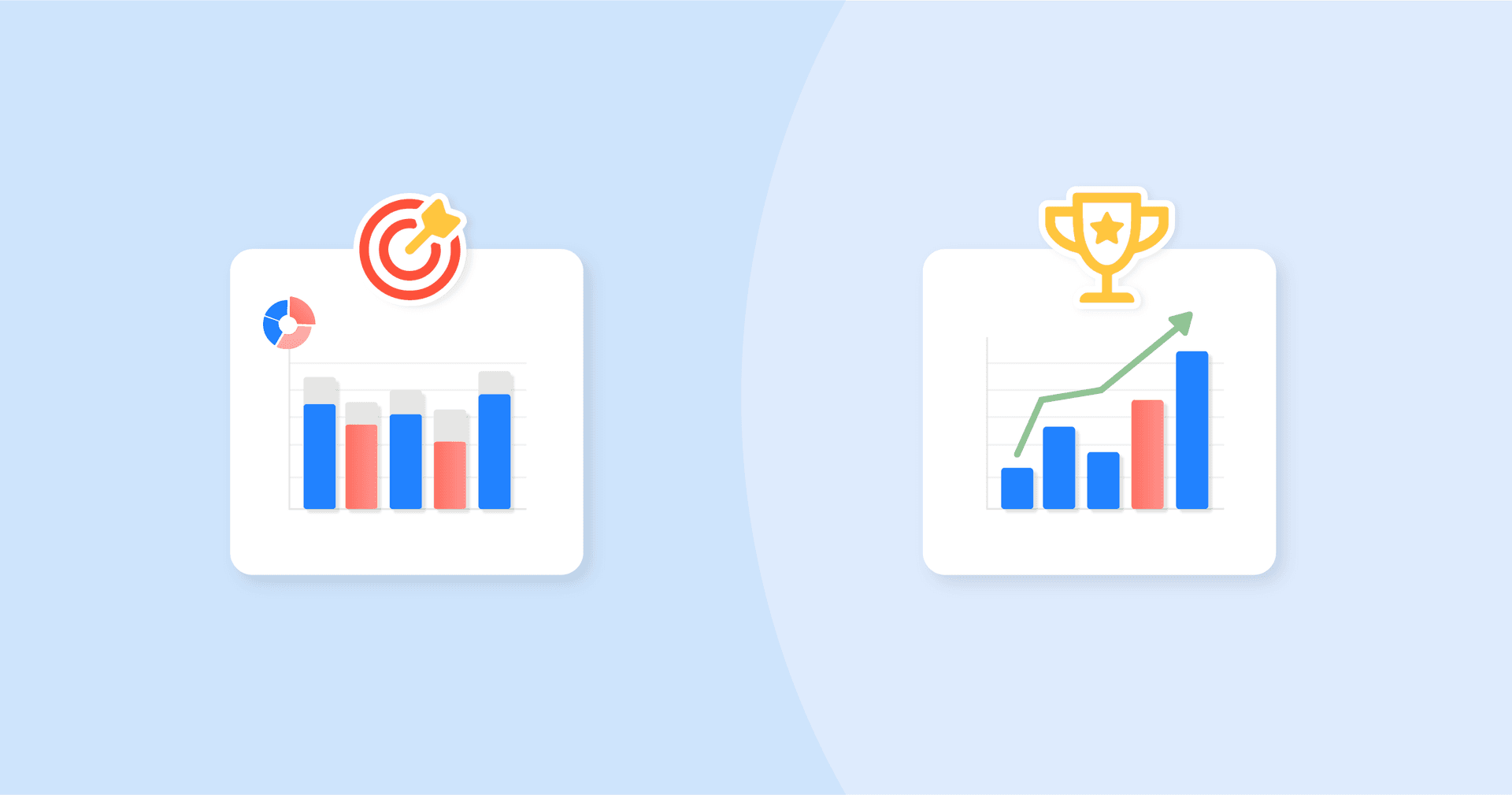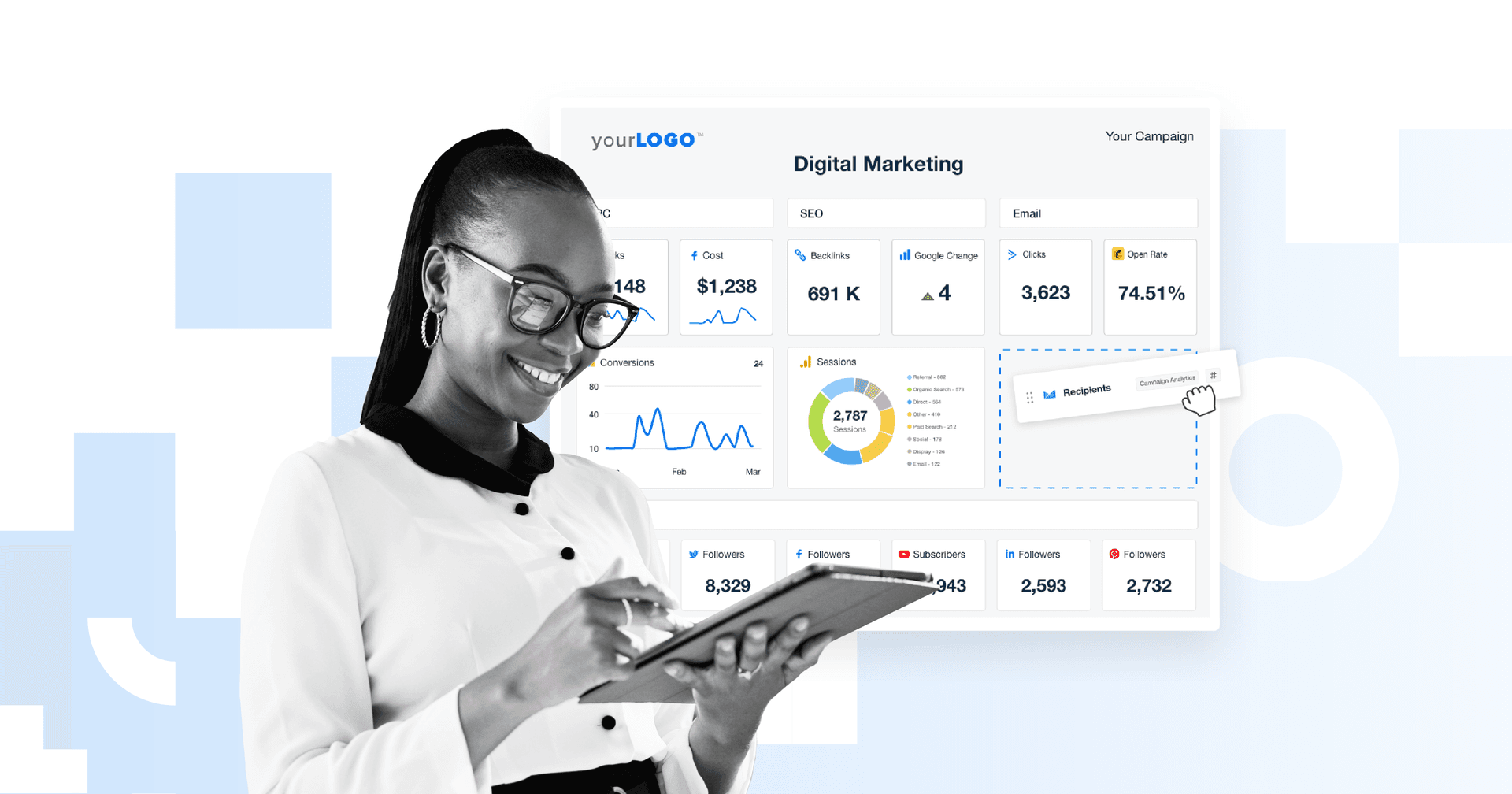Table of Contents
Table of Contents
- Why Smart Key Performance Indicators (KPIs) Matter for Client Success
- Understanding SMART: Breaking Down the Components
- How To Choose the Right Smart KPIs for Different Campaigns
- Tracking Smart KPIs: Tools and Techniques
- Reporting SMART KPIs to Clients
- Common Pitfalls in Setting SMART KPIs and How to Avoid Them
- Summary & Smart KPI Takeaways
7,000+ agencies have ditched manual reports. You can too.
Free 14-Day TrialQUICK SUMMARY:
SMART KPIs transform broad marketing goals into clear, actionable targets, following criteria that make each objective: Specific, Measurable, Achievable, Relevant, and Time-bound. This approach replaces guesswork with precision, guiding marketing teams in tracking what works, refining strategies, and making impactful improvements. This article details how SMART KPIs empower campaigns with measurable, client-centered results.
Tracking key performance indicators, or KPIs, is the name of the game for any successful marketing campaign. However, setting those KPIs without direction or precision often leads to guesswork instead of results.
What if you could turn vague goals into measurable results? This is where SMART KPIs come in—a simple yet powerful way to turn broad goals into clear, measurable targets.
So, what makes a KPI “smart”? It’s not just about setting goals; it’s about setting the right goals. Similar to SMART goals: every KPI should be Specific, Measurable, Achievable, Relevant, and Time-bound.
This focus helps marketing teams see exactly what’s working (or not) in their strategies, providing a solid path to track progress and drive improvements that make a real difference to clients.
Why Smart Key Performance Indicators (KPIs) Matter for Client Success
Incorporating SMART KPIs into a campaign is the difference between meeting baseline metrics and achieving meaningful client success. Yes, a key performance indicator (KPI) serves as a guide to assess progress toward strategic goals. However, only SMART KPIs—those based on the SMART criteria—provide a precise framework for evaluating business performance.
By setting KPIs that align directly with specific goals, each target becomes a step forward in driving results that matter.
Using SMART KPIs also drives business performance by ensuring that all campaign efforts contribute to the bigger picture. And who doesn’t want better business performance?
Aligning KPIs with strategic goals keeps the focus on long-term objectives rather than short-term wins. This alignment helps build a consistent path toward growth, enabling precise and quantifiable achievements that reflect real progress.
Understanding SMART: Breaking Down the Components
SMART criteria provide a structured framework for setting KPIs that drive meaningful results. By ensuring each key performance indicator meets these five components—Specific, Measurable, Achievable, Relevant, and Time-bound—teams set measurable goals that align with strategic objectives and deliver clear insights into campaign progress.
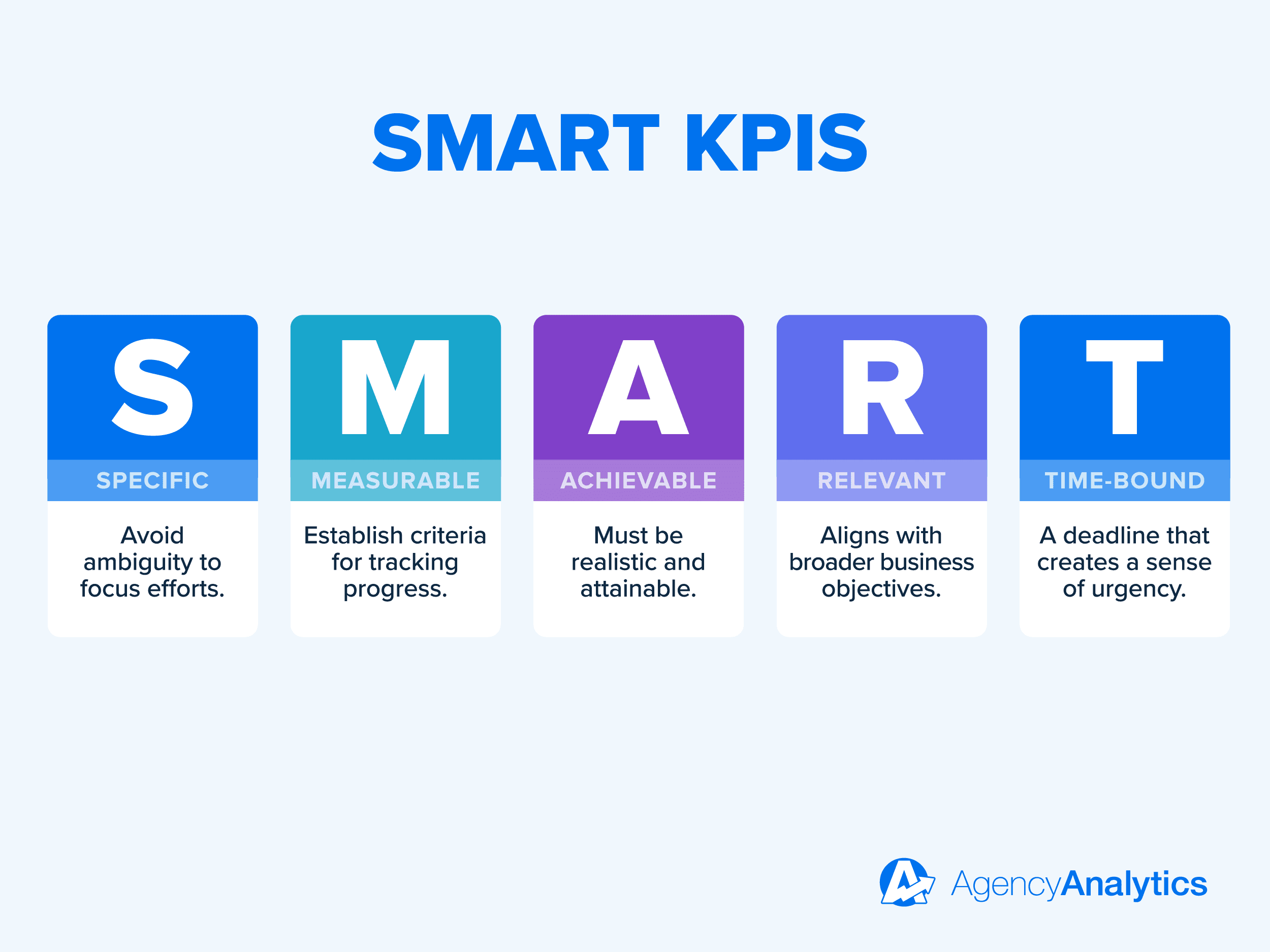
Specific
Specific KPIs focus on what a campaign aims to achieve, leaving no room for vague intentions. This level of clarity directs all efforts toward a well-defined outcome.
EXAMPLE: Rather than simply aiming to "increase organic traffic," a specific website KPI could be “increase organic traffic by 20% over the next quarter.” This target removes ambiguity, making it clear to all team members what the exact goal is and aligning their efforts with actionable steps.
Measurable
Measurability in KPIs ensures that success is tracked through quantifiable metrics, which is essential for objectively evaluating progress. Defining measurable goals enables teams to assess whether the campaign moves toward its target or requires adjustments.
EXAMPLE: A campaign aiming to reduce customer acquisition cost could set a KPI to “lower customer acquisition cost by 15% within six months.” This performance measurement allows for a clear assessment based on actual data, offering a benchmark to gauge success.
Achievable
Setting achievable KPIs is crucial for realistic progress. Goals should be based on historical data, current resources, and the campaign’s potential. Overambitious targets may lead to disappointment, while attainable marketing goals keep momentum and motivation high.
EXAMPLE: If historical data indicates that average monthly traffic growth is 5%, a goal to increase traffic by 6-7% may be realistic and motivating, while targeting 15% might not align with current capabilities.
Relevant
Relevant KPIs ensure alignment with a client’s strategic objectives and business priorities. KPIs should directly contribute to the bigger picture and deliver insights into areas that matter most for client success.
EXAMPLE: When a client aims to improve customer satisfaction, a relevant KPI could focus on “achieving a 90% satisfaction rating by year-end,” directly contributing to the broader goal of customer loyalty and retention.
Time-bound
Every KPI needs a time frame to create a sense of urgency and facilitate progress tracking. Deadlines encourage regular evaluation and timely adjustments when needed.
EXAMPLE: A time-bound (or timely) social media KPI could be to “increase social media engagement by 10% within the next 60 days.” The time frame defines when the goal should be met, guiding the campaign’s pace and making it easier to measure progress consistently.
Each component of the SMART framework ensures that KPIs are not just goals but practical tools that drive strategic growth, boost accountability, and focus efforts on what truly matters for client success.
How To Choose the Right Smart KPIs for Different Campaigns
Choosing effective KPIs requires a strong alignment between the campaign’s goals and the broader business objectives. By selecting SMART KPIs that fit the campaign type, business goals, agency capabilities, and other key considerations, teams ensure that each metric supports performance management and overall business performance.
Align to the Campaign Type or Channel
Smart KPIs should reflect the unique characteristics of the campaign type or the channels in use. For example, a social media campaign might focus on engagement metrics like click-through rate or follower growth. In contrast, a customer retention campaign may prioritize customer satisfaction and repeat purchase rate metrics.
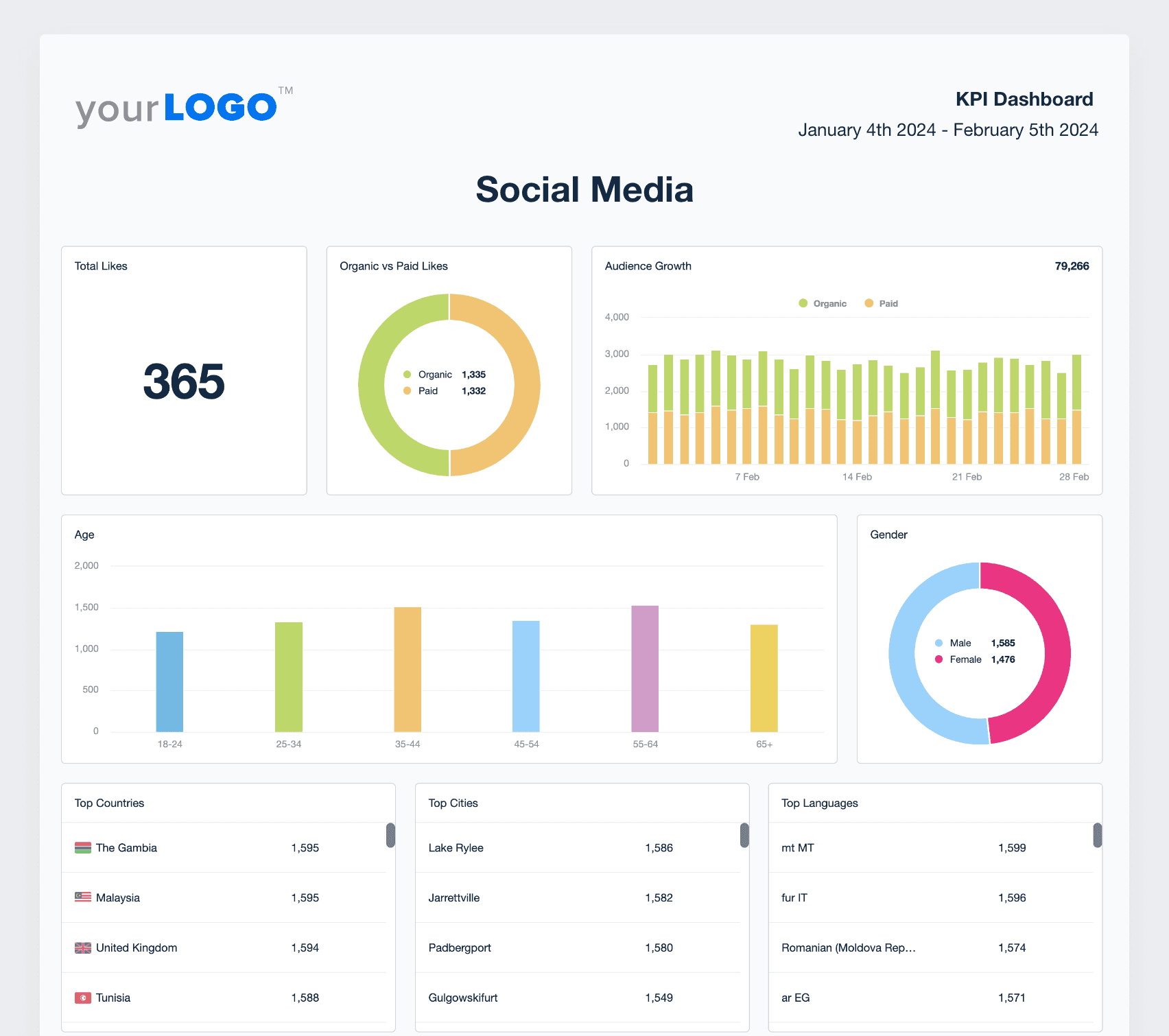
Each channel or campaign type demands KPIs that capture the right outcomes and allow for targeted strategy adjustments.
Align to Business Objectives
Effective KPIs must directly contribute to the client's business goals. For instance, if a client’s objective is to increase sales or market share, KPIs might focus on customer acquisition metrics, such as reducing customer acquisition costs or increasing conversion rates.
Aligning KPIs with specific business objectives ensures that campaign results translate into overall business performance improvements, giving the client and agency a clear path to achieve strategic priorities.
Align to Agency Capabilities
Connecting KPIs to agency capabilities helps ensure the selected goals are realistic and achievable within the available resources and expertise.
For example, if an agency has strong SEO capabilities but limited resources for video content, focusing on SEO-driven KPIs like organic search growth or keyword rankings will yield more manageable, impactful outcomes.
Align to Client Expectations, Benchmarks, or Industry Standards
Beyond aligning with campaign type and business objectives, effective KPI selection should also consider client expectations and industry benchmarks.
Understanding a client’s expectations for growth and the average industry standards will help set challenging and realistic KPIs. This alignment balances ambitious goals with practical outcomes, supporting long-term client satisfaction and fostering trust through transparent performance management.

Automatically include industry benchmarks in your client reports to show off how your performance exceeds the industry average (or flag for optimization when it doesn’t). Try AgencyAnalytics free for 14 days.
By aligning SMART KPIs with these critical factors, teams build a solid foundation for tracking success, optimizing campaigns, and supporting a client’s strategic growth in a meaningful, measurable way.
Tracking Smart KPIs: Tools and Techniques
Tracking SMART KPIs effectively requires the right mix of tools, custom dashboards, monitoring alerts, and clear data visuals. These methods help teams stay aligned with client goals and communicate KPI progress clearly and effectively.
Choosing the Right Tools
Popular tools like AgencyAnalytics, Klipfolio, DashThis, Databox, Google Data Studio, and Whatagraph offer different features for tracking SMART KPIs. These platforms help teams centralize KPI data, automate reporting, and analyze channel metrics.
And you can probably guess which one we’d recommend, especially for a marketing agency!
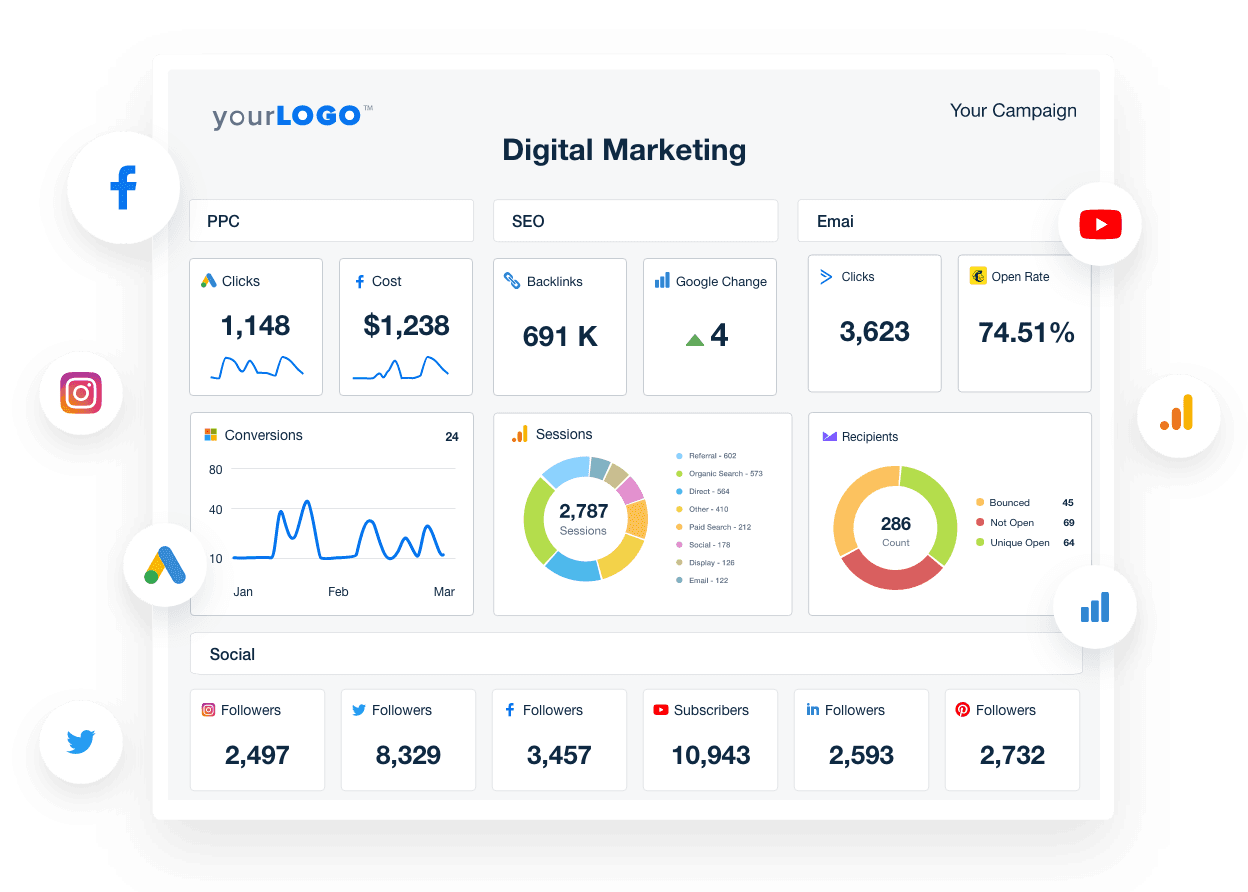
The right tool depends on campaign complexity, desired integrations, and customization needs.
Building Custom Dashboards
Custom dashboards enable teams to visualize KPI progress in real time and keep everyone aligned with client objectives. With custom views for each client, teams focus on key metrics—like customer acquisition cost or employee satisfaction—that reflect specific campaign goals.
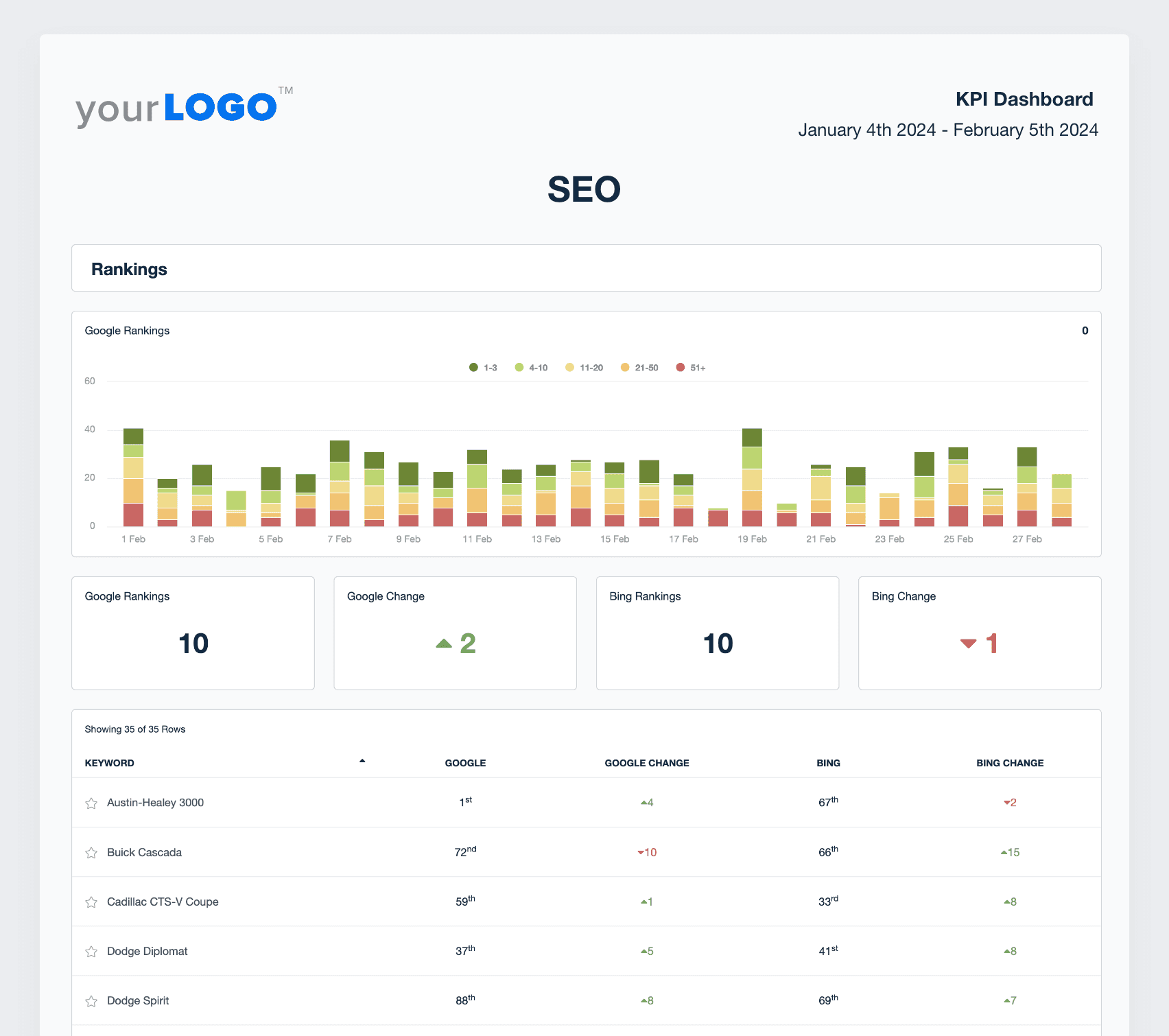
Track the KPIs that show your impact. With AgencyAnalytics, monitor real-time metrics that matter most—start a free 14-day trial today.
This helps teams stay on track with the data that directly informs campaign decisions and ensures continuous alignment with client expectations.
Setting Up Alerts for KPI Monitoring
Setting up alerts on important metrics helps teams stay proactive and responsive. By receiving notifications for major shifts—such as a drop in engagement or an increase in conversion rate—teams make timely adjustments to campaigns.
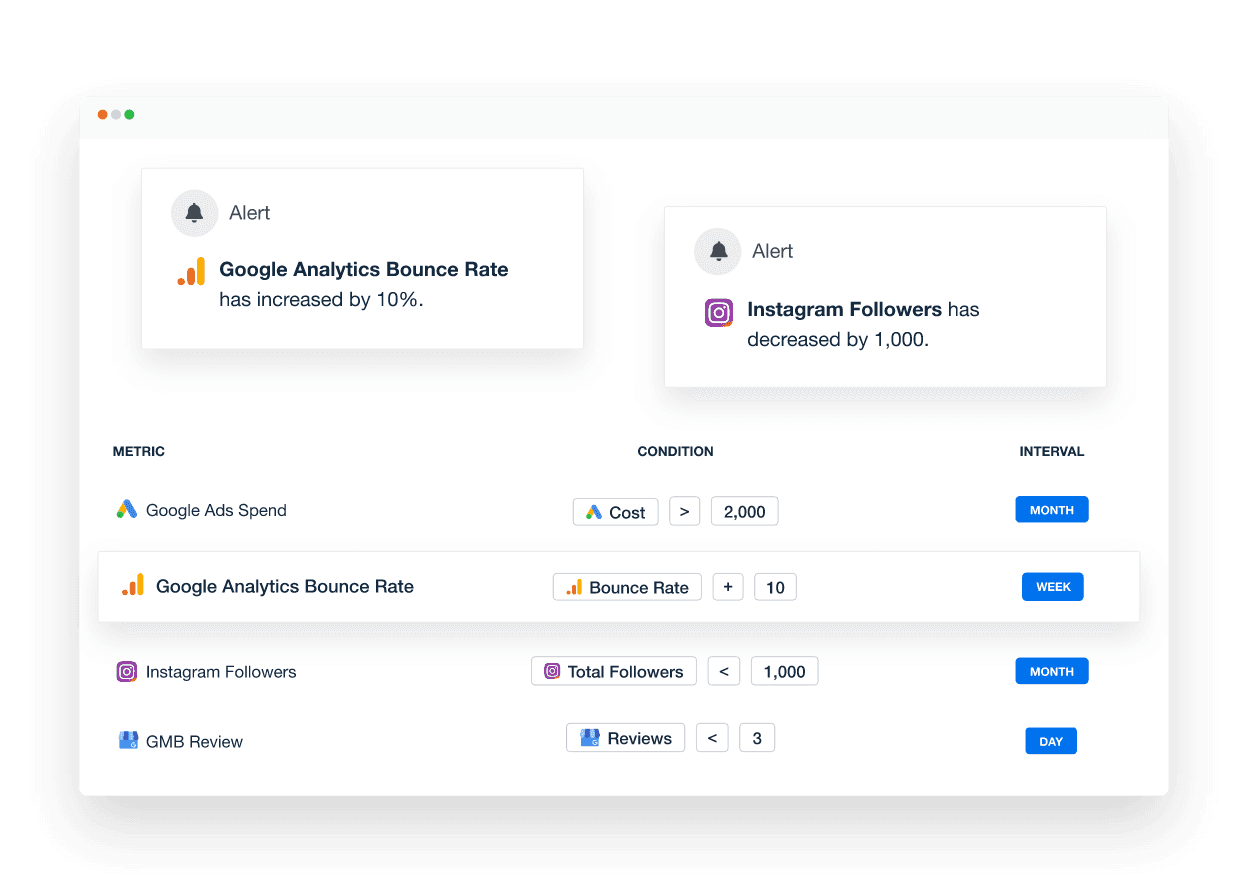
Alerts help prevent minor issues from growing into larger setbacks, supporting more consistent KPI performance.
Best Practices for Data Visualization
Data visualization is essential for effectively communicating KPI progress to clients. Best practices include using simple and clear visuals, like bar charts or line graphs, to highlight trends and avoid clutter.

Consistently labeled metrics, color coding, and concise descriptions help clients quickly grasp the meaning behind each visual, creating transparency in campaign performance and aligning efforts with client priorities.
Using these tools and techniques for KPI tracking helps streamline performance management, keeps teams agile, and ensures that every campaign focuses on delivering measurable, client-centered results.
Reporting SMART KPIs to Clients
Effectively reporting SMART KPIs to clients requires clear, tailored communication highlighting meaningful metrics and actionable insights.
Tailoring KPI Reports to Client Needs
Customizing reports to emphasize KPIs that align with client priorities ensures that each report speaks to what matters most for their business.
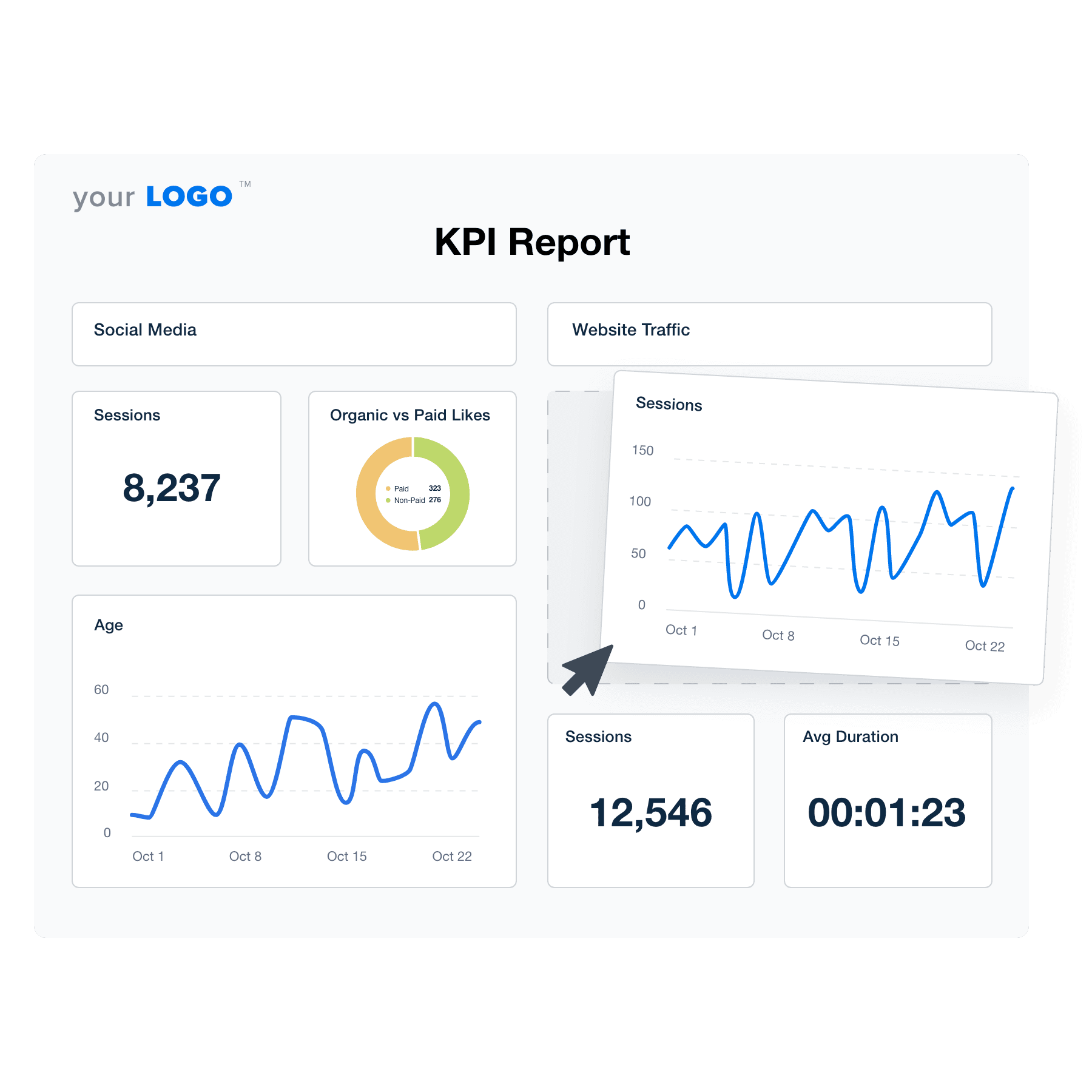
For instance, clients focused on customer acquisition may value SMART KPI examples related to lead conversion or acquisition cost. Adjusting reports based on client feedback and industry context keeps presentations relevant, helping clients see how campaigns directly contribute to their goals.
Explaining KPIs in Simple Terms
When presenting complex data, simplicity is vital. Using straightforward language and visuals makes it easier for clients to understand KPI progress without extensive technical knowledge.
For example, instead of detailing the technical details behind the data, focus on what the data represents. Instead of “The ratio of NPS detractors has decreased,” try something that would resonate better with the client, such as “We’ve seen a 10% increase in customer satisfaction this quarter.”
Highlighting Wins and Opportunities for Growth
Balancing KPI reports by celebrating achievements and identifying growth opportunities offers a comprehensive view of performance. Highlighting wins, such as hitting a key SMART KPI target, reinforces progress, while pinpointing areas for improvement shows proactive planning.
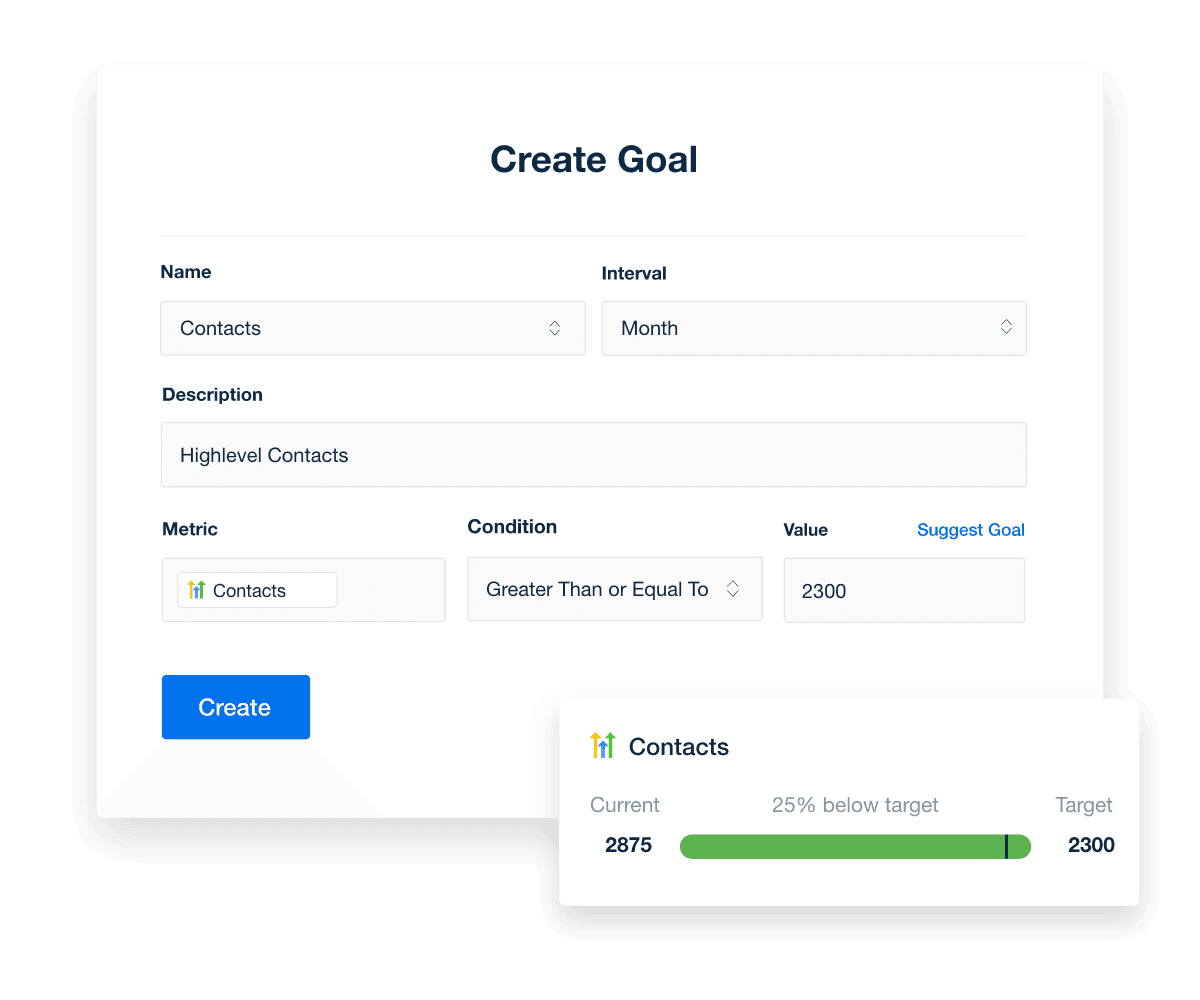
Set SMART KPI goals and watch the progress unfold. Track your metrics against targets in real time and see how each campaign measures up—start your free 14-day trial today.
For example, if a campaign met customer engagement goals but has room for growth in conversion rates, highlight this as an area for potential optimization in future strategies.
Client Communication Tips for KPI Discussions
Regular check-ins help keep clients informed and allow open discussion around KPIs. Establishing a monthly or quarterly cadence for updates ensures clients stay in the loop on progress. During these discussions, encourage clients to ask questions and share feedback to deepen alignment. It’s also important to consider HOW you share these KPIs.
According to the Marketing Agency Management Benchmarks Report, nearly 80% of agencies lean toward live KPI dashboards for their real-time insights, enabling agile adjustments as new data emerges.
Clients, however, tend to prefer static reports, like a monthly marketing report, which provides a clear, comprehensive snapshot of progress over time.
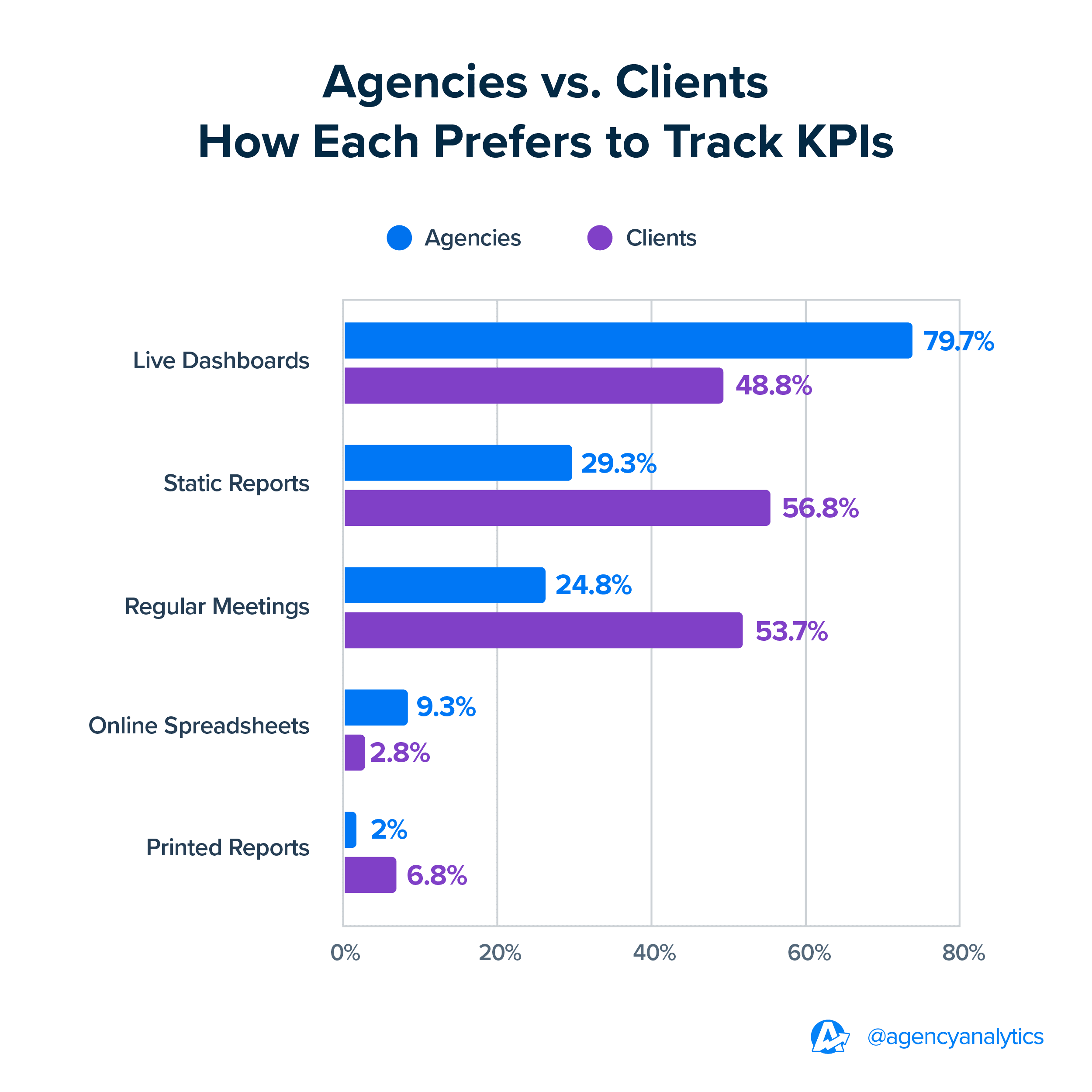
Common Pitfalls in Setting SMART KPIs and How to Avoid Them
Successful KPI development requires careful planning and regular review. Avoiding common pitfalls in setting SMART KPIs ensures they remain actionable, focused, and aligned with client goals.
Below are some common challenges and strategies to sidestep them.
Setting KPIs That Are Too Vague
Vague KPIs often fail to provide clear direction, leading to confusion and unfocused efforts. A general KPI like “increase engagement” lacks specificity, making it hard to measure success or drive actions. Instead, KPIs should be defined with precise targets, such as “increase organic engagement by 15% in six months.” This clarity helps teams stay on course and track meaningful progress.
Overloading on KPIs
Tracking too many marketing KPIs or operational metrics dilute a team’s focus and make it challenging to prioritize key objectives.
According to the 2024 Marketing Agency Management Benchmarks Report, most agencies track less than 10 KPIs per client.

When KPI development emphasizes quantity over quality, tracking becomes overwhelming and often ineffective. Distinguish between KPIs vs. metrics; KPIs should reflect only the most important goals.
Ignoring Relevance to Client Goals
KPIs that don’t align with client goals may lead to misguided strategies and weaken client relationships. For instance, focusing solely on brand awareness when the client’s main priority is lead generation could misdirect efforts.
By prioritizing KPIs that support client-specific objectives, teams build trust and demonstrate a commitment to client success.
Failing To Review and Adjust Regularly
SMART KPIs should evolve with client needs and market conditions, so regular reviews are essential. Ignoring this may lead to outdated or misaligned KPIs.
Setting quarterly or biannual reviews ensures KPIs remain relevant and responsive to industry shifts or new client priorities. Regular evaluation helps maintain focus on impactful goals and keeps strategies aligned with current objectives.
By avoiding these pitfalls, teams ensure their KPIs are specific, impactful, and aligned with the client’s evolving needs, leading to more effective tracking and stronger outcomes.
Summary & Smart KPI Takeaways
Setting SMART KPIs—Specific, Measurable, Achievable, Relevant, and Time-bound—offers a reliable framework for guiding marketing strategies and measuring success. When aligned with client goals, these KPIs provide clarity, focus, and actionable insights into campaign performance.
Key Takeaways
SMART KPI Structure: SMART KPIs are built on precise, actionable components that make it easier to track progress and adjust strategies effectively.
Choosing Aligned KPIs: KPIs should match the campaign type, client business goals, agency capabilities, and industry standards to drive relevant outcomes.
Tools and Techniques: Utilize tracking tools, custom dashboards, monitoring alerts, and data visualization techniques and best practices to manage and communicate KPI progress.
Effective Client Reporting: Tailor KPI reporting to client needs, simplify complex data, and regularly highlight achievements and growth opportunities.
Avoiding Common Pitfalls: Set specific KPIs, limit their number, align them with client goals, and review them regularly to ensure they remain relevant and achievable.
This approach to KPIs helps build stronger campaigns, track meaningful metrics, and create value that aligns with client objectives.


Written by
Paul Stainton is a digital marketing leader with extensive experience creating brand value through digital transformation, eCommerce strategies, brand strategy, and go-to-market execution.
Read more posts by Paul StaintonSee how 7,000+ marketing agencies help clients win
Free 14-day trial. No credit card required.




